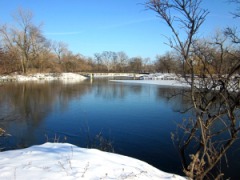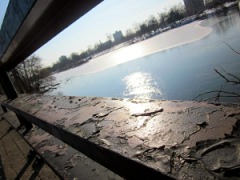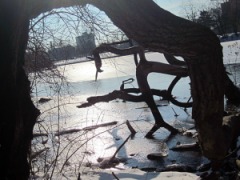 First snow in the city hearkens fresh opportunity. A physical manifestation of the cold we love to suffer through, it’s at first beautiful and fun. From bright colors to newly blanketed contours, everything stands out; and before the plows, footsteps, and slush clamor in your everyday landscape is an undisturbed ermine mantle.
First snow in the city hearkens fresh opportunity. A physical manifestation of the cold we love to suffer through, it’s at first beautiful and fun. From bright colors to newly blanketed contours, everything stands out; and before the plows, footsteps, and slush clamor in your everyday landscape is an undisturbed ermine mantle.
Jackson Park – Chicago, IL
I indulged in Chicago’s first snowscape of 2012 in Jackson Park on the city’s south side. The site of the 1893 Columbian World’s Exposition, the 500 acre park was built with splendor in mind. Jackson Park was designed by Frederick Law Olmsted, considered to be the father of American landscape architecture. As a contrast to the magnificent drama of the World’s Fair, Olmsted created a serene sylvan scene along Lake Michigan.¹
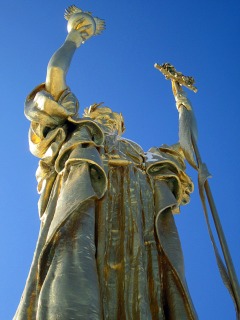
The grand gleaming buildings and electric lights of the fair prompted its nickname “The White City.” Much of the White City’s glory, intended to be temporary, has long been lost but a few vestiges remain in Jackson Park. “The Republic” is a stately, shining tribute to the fair. It’s hard to believe the compelling colossus is only one-third the size of the original 65 foot piece sculpted by Daniel Chester French. The gorgeous golden replica was commissioned to commemorate the 25th anniversary of the fair as well as the state of Illinois centennial.²
Only one structure original to the Columbian Exposition still stands in Jackson Park. The Museum of Science and Industry was home to the Palace of Fine Arts during the fair and is currently the largest science museum in the Western Hemisphere.³

The gem of Jackson Park is Olmsted’s Wooded Island. Olmsted envisioned, “a place of relief from all the splendor and glory and noise and human multitudinousness of the great surrounding Babylon.”¹ Nestled in the midst of the park’s lagoons, the island’s Osaka Garden provides a peaceful refuge in the Japanese garden style. Traipsing over the garden’s graceful bridges and paths, examining the snow-lined boughs and waterfront it resident wildlife scurrying, it’s hard to believe I’m a few miles from the Second City’s center. In warmer weather, Jackson Park’s beach, golf course, and paths, continue to draw crowds but Olmsted’s vision of serenity in the city continues to be a world-class success.





Central Park – New York, NY
I enjoyed a similar January jaunt last year in New York’s Central Park. The first landscaped park in the United States, it was also designed by Frederick Law Olmsted in collaboration with Calvert Vaux. Olmsted regarded the park as, “of great importance as the first real Park made in this century—a democratic development of the highest significance.”4
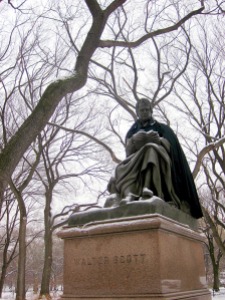 Central Park is the most visited urban park in the country (Lincoln Park is second), attracting approximately thirty-five million visitors each year.5 The park was opened in 1857 on 770 acres, later expanding to 843 acres. The construction effort was massive, requiring the eviction of hundreds of residents, and the use of more gunpowder in the clearing than was used at the battle of Gettysburg.6
Central Park is the most visited urban park in the country (Lincoln Park is second), attracting approximately thirty-five million visitors each year.5 The park was opened in 1857 on 770 acres, later expanding to 843 acres. The construction effort was massive, requiring the eviction of hundreds of residents, and the use of more gunpowder in the clearing than was used at the battle of Gettysburg.6
Central Park evolved from an urban oasis and posh promenade for the wealthy during the Gilded Age to place of recreation for the city’s working class families by the early twentieth century. The outdoor concerts, sit-ins, and freewheeling frolicking at Bethesda Fountain of the 1960’s gave way to financial cuts in the 70’s that led to a severe decline in maintenance and heightened crime rate.7 Since the 1980’s, the Central Park Conservancy has led restoration and reclamation efforts in the park. Today, Central Park’s playgrounds, pools, six miles of paths, performances, zoo, sledding hills, and skating rinks are enjoyed as New York City icons.
Central Park is the most filmed location in the world, with a supporting role in over 300 films.8 I braced myself for a sighting of Home Alone 2‘s pigeon lady or Ice-T chasing someone down SVU-style but nothing so nefarious was afoot for my winter ramble. There’s something I love about a city in winter. The tourists dwindle and you can more clearly appreciate its essence. Strolling past Poet’s Alley and freshly powdered lamp posts I wondered at the families busy about their winter recreation. Red and black bundles zigzagged down the sledding hill. What would it be like to have Central Park as your backyard?
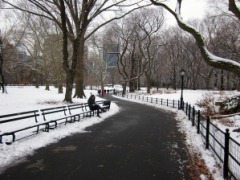
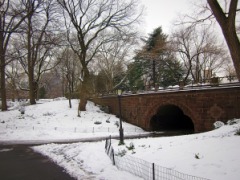
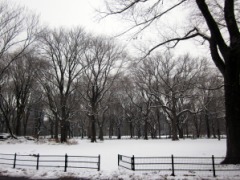

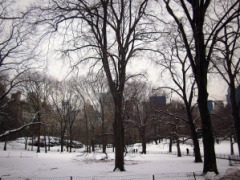
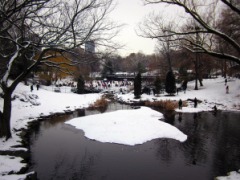

Frederick Law Olmsted’s city retreats are lovely landscapes in any season, but there’s something elemental about exploring them in the snow. While Jackson Park was meant to remain bucolic long after the bustle of the World’s Fair vanished, Central Park has seen ups and downs in the evolution of its use as the backyard of the world’s city. I think Olmsted would be satisfied to see the continual enjoyment of his designs, whether touched by the summer sun or the onset tide of snowfall.
For Further Exploration:
Attempting a Hyde Park Bike Tour
1. Martin, Justin. “Jewels of Olmsted’s Unspoiled Midwest.” NY Times. 02 Sept. 2011.
2. “Statue of the Republic.” Explore Chicago | The Official Chicago Tourism Site.
3. “Jackson Park, MSI.” Explore Chicago | The Official Chicago Tourism Site.
4. “Central Park Early History.” Citimaps.
5. “The Most-Visited City Parks.” The Trust for Public Land 2011 City Park Facts.
6. “New York City’s Central Park | History.” CentralPark.com.
7. “CentralParkHistory.com.” 1960’s History – The Freaks at the Fountain. Central Park History.
8. “Films Shot in Central Park.” Central Park Sunset Tours.

